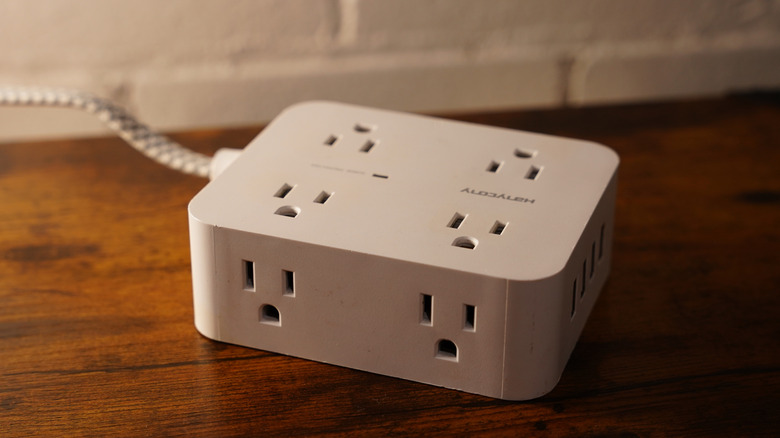HGTV's Mike Holmes Shares The Essential Upgrade He Makes At Every Opportunity
It took Mike Holmes experiencing firsthand what it's like to be unprotected against a power surge to understand the importance of a surge protector. You see, your building's power supply isn't stable, even though it looks that way. The voltage fluctuates (typically 0 to 169 volts), and a power surge can occur if it exceeds the range safe for home appliances. This high voltage can damage your appliances and force you to start making surprise repairs around your home. This is why we agree with Mike Holmes when he says you need a power surge protector to safeguard electrical appliances and wiring.
And it's not just the fluctuating voltage or electrical overload that causes these surges. Other culprits include lightning strikes, faulty wiring, even restorations after power outages. While there are many survival hacks you'll need during a power outage, having a surge protector might be the only effective survival hack available for home appliances.
Think of a surge protector as an electric gatekeeper. Most of the time, it allows the supply of electricity from the outlet directly to any connected devices, but when there's a power spike, it redirects excess electricity to the outlet's ground wire safely. This safeguards your building's electrical system and wiring. A surge protector also improves safety since it helps prevent the risk of electrical fires resulting from an overload. When you consider the damages avoided, this investment serves as long-term insurance that preserves and even improves the lifespan of your appliances.
What you need to know before getting a surge protector
Before you waltz over to Amazon or Home Depot for a surge protector, there are a few things you need to consider. First, its joule rating. In this case, you're looking at the amount of electrical energy the surge protector can absorb before you need to replace it. Here, we advise you to go for protectors with higher joule ratings to get the best performance and lifespan.
Next, you need to consider the clamping voltage, which is the voltage level at which your surge protector begins to divert excess electricity. In this case, lower is better, and you're generally better off going for a surge protector closer to a 330V rating instead of a 4,000V rating. The device should also have a UL certification signifying it has passed the safety standards for preventing injury, electrical shocks, and fire hazards.
Finally, consider what type of surge protector you need. Whole-house or panel-mounted surge protectors are installed at your electrical panel and defend your entire home against large surges from lightning or grid issues. This is the version that Holmes says he and his team now install in every panel on every project following his personal experience without one. Installing this type of protector is an electrical project you should not attempt at home unless you're a professional. A point-of-use surge protector is a standalone power strip with several outlets, preventing damage from small voltage spikes to everyday devices and small appliances. In this case, choose one with widely spaced outlets that accommodate different plug types.

